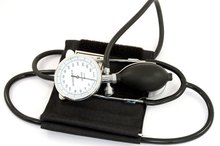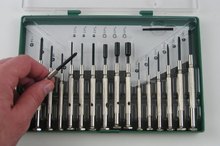O2 Cylinder Hydrostatic Test Requirements
Oxygen cylinders are used to provide oxygen for a variety of uses such as medical, industrial and technical scuba diving. The tanks are required to be tested to make sure they can safely hold the designated working pressure of oxygen. The hydrostatic testing procedure involves filling the tanks with water, sealing them and immersing them in a water-filled hydrochamber. The chamber is sealed and the tanks are then pressurized to much greater than the working pressure to test the structural integrity.
Pressurization Levels During Testing
The tank's working pressure is the pressure to which it is normally considered full. The hydrostatic test fills the tank to 1 2/3 of the working pressure. The reason for this is to ensure the tank is capable of holding gas pressures far greater than it is normally required to. To give an example, during hydrostatic testing an oxygen tank with a designated working pressure of 300 bar will be pressurized to 500 bar. Hydrostatic rules dictate that the pressure must be held for at least 30 seconds to allow the tank walls to fully expand, before it is depressurized.
- The tank's working pressure is the pressure to which it is normally considered full.
- To give an example, during hydrostatic testing an oxygen tank with a designated working pressure of 300 bar will be pressurized to 500 bar.
Expansion Limits
Equipment for Checking Blood Pressure
Learn More
An acceptable expansion of the tank following depressurization is to within 10 percent of the reading taken when the tank is pressurized. For example: A 10-liter tank expands by 1 liter when pressurized during the hydrostatic test. To pass the test the tank expansion must not be greater than 0.1 liters following depressurization.
Recording
All oxygen cylinders are required to have the date of the last hydrostatic test on the neck of the tank. This is to show users of the tank when the next due test date is and to verify the tank is safe to use.
Period Between Testing
How to Troubleshoot a Blood Pressure Monitor
Learn More
Oxygen cylinders must be tested every five years. Testing must occur sooner if the cylinder is dropped from a height, exposed to heat damage or painted with an inappropriate substance.
Related Articles
References
- Deep Six: Hydrostatic Test Equipment
- Bood, SA., Ulf Sundequist,U., Kjellgren, A., Gun Nordstrom1,G. and Torsten Norlander, T. (2007). Effects of Flotation REST (Restricted Environmental Stimulation Technique) on Stress Related Muscle Pain: Are 33 flotation sessions more effective than 12 sessions? Social Behavior and Personality, An International Journal.
- CBS News. (2018). Pay Attention: How sensory deprivation and floating impact the mind. CBSNews.com.
- Feinstein, JS., Khalsa, S., Yeh, H., Wohlrab,C... Paulus, MP. (2018). Examining the short-term anxiolytic and antidepressant effect of Floatation-REST. PLOS One. doi:10.1371/journal.pone.0190292
- Kjellgren, A., Westman, J. (2014). Beneficial effects of treatment with sensory isolation in flotation-tank as a preventive health-care intervention – a randomized controlled pilot trial. BMC Complementary and Alternative Medicine.
Writer Bio
Mark Slingo has been a professional writer since 2008. His work has appeared in Forward, ScubaGlobe, Scuba Jedi, "Pattaya Mail" and other publications. Slingo has a Bachelor of Arts in politics from the University of Newcastle and a diploma in journalism from the British College of Journalism.








